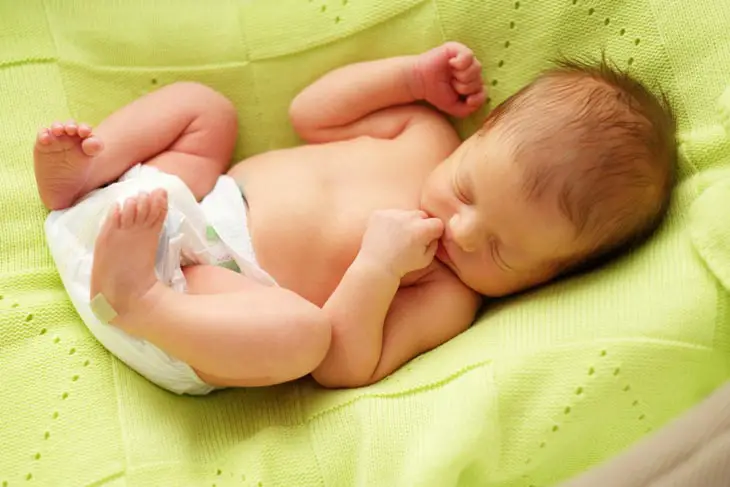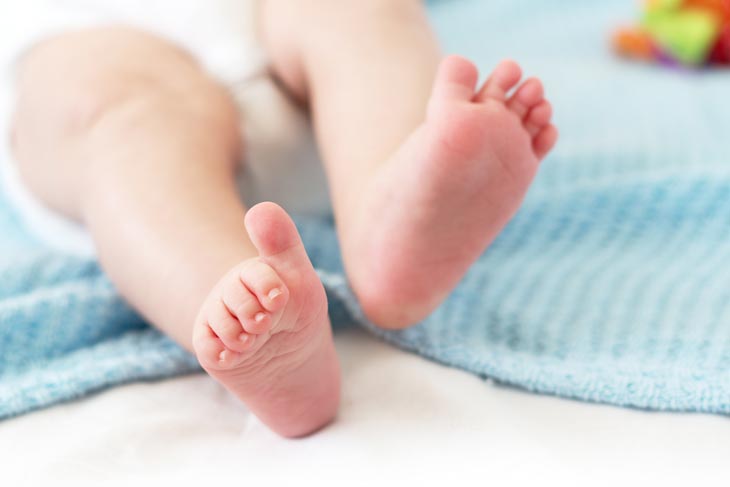Your baby throwing legs up and down in sleep? Well, seems like nothing is out of place – he is still only a few months of age, after all.
But once these frequencies surge at an alarming rate – to the point that his kicking even disturbs your sleep at night – ignorance is no longer a wise choice.
Now is the time to sit down and properly assess the issue at hand.
Our guidelines will deliver some helpful pointers to navigate around the dilemmas of baby lifting legs while sleeping. Check them out!
Why Is Your Baby Throwing Legs Up and Down in Sleep?

Why do babies lift their legs up while sleeping?
Occasional kicks in the first two or even three months are pretty common in healthy babies – an instinctual reflex to strengthen muscles.
But if newborn lifts legs while sleeping for more than six months at a startling frequency, that might indicate restless legs syndrome or periodic limb movement disorder.
1. Babies of Two or Three Months Old
For newborn babies that have barely gotten out of your womb for a few months, we have some good news: the child is still within a safe zone.
Keep in mind that he has been in a curled position for almost a year within your body, long enough for you to feel the baby kicking against your stomach!
Hence, it is only natural that some lingering remnants of this long-standing habit remain after birth.
As a type of moro reflexes to solidify muscle strengths, his leg motions are more instinctual than actual indicators of diseases.
Once the infant finally warms up to his surroundings, you can be assured that these repetitive movements during his nap times will come to an eventual stop.
2. Babies of Six Months Onwards
Let’s say, for some mysterious reason, the baby lifts legs in sleep even after half a year. Under such circumstances, frequencies play a critical role here:
A sparse rate of only once a week (or once a month) means things are still going in the right direction.
That is probably only his startle reflex, which most children that age are still unable to grasp full control over. No immediate solutions are needed; all you should do is wait.
Unfortunately, the case of baby lifting legs in air at night might turn much grimmer if nights of restless sleep persist without a stop.
The worst scenario entails possibilities of periodic limb movement disorder or restless leg syndrome – two popular causes of sleep disturbance.
Of course, it is too soon to jump into such a conclusion solely from seeing your baby lifting legs in air.
Our next section will unveil some additional symptoms of sleep disorders you should consider.
What Is Restless Leg Syndrome And Its Symptoms?
Restless Leg Syndrome (RLS) implies a strong need to move the limbs due to long-enduring aches.
Midday fatigue, sleep troubles, and constant leg kicking are the most transparent signals of this disorder.
Children with a medical history of ADHD or from a family with RLS are likely to suffer from it, too.
1. Definition
As the National Institute of Health issued, restless leg syndrome (or RLS) refers to a sensory disease that causes a strong desire to move the legs around.
In most cases, this desire stems from burning discomfort induced by too much inactivity, often described in popular adjectives such as “crawling”, “creeping”, “tingling”, or “scorching”.
Patients report constant leg kicking helps them relieve the bothersome sensation.
Under severe degrees, restless leg syndrome might lead to immense sleep troubles.
2. Symptoms of RLS
The most obvious symptoms involve an overwhelming array of limb movements. Some cases in point are tossing, flexing, stretching, pacing, twisting, and jiggling.
Other signals entail:
- An unpleasant and itching sensation in the limbs.
- Troubles falling asleep
- Midday symptoms of sleep deprivation (which also includes daytime fatigue).
- Weakened health condition and increasing pains
- Another relative or family member with RLS (these symptoms can be genetic)
- Previous diagnosis of ADHD (Attention-deficit and hyperactive disorder). Scientists have pointed out the connection between the two disorders.
Identifying some of these indicators in older children and adults is quite a breeze. Infants, however, are an entirely different case.
They can barely talk, let alone describe exactly how they feel to their worried parents!
Thus, we suggest you keep a close eye on the child to ensure nothing unusual is skimmed over.
What Is Periodic Limb Movement Disorder (PLMD) And Its Symptom?
Periodic limb movement disorder (PLMD) hampers sleep quality by a strong desire to kick both legs around. PLMD movements often occur in clusters every 21 to 30 seconds.
Other popular symptoms also include hyperactiveness, anxiety issues, and a tendency to fall asleep in the middle of daily activities.
1. Definition
PLMD (Periodic limb movement disorder, formerly known as sleep or nocturnal myoclonus) is a type of neurological condition.
It impairs one’s ability to stay motionless at night, which has a detrimental effect on sleep quality. Any age and gender can be subjected to these ailments.
Short leg motions often occur about every 21 to 30 seconds in small clusters, which may last from several minutes to a few hours!
The duration of each cluster is not consistent, and in severe cases, these PLMD movements do not necessarily occur only at night.
Both RLS and PMD are involuntary and unconscious impulses to stretch the lower limbs.
One major difference lies in the brain states: PLMD patients are completely unaware of the movements (as they are deep in slumber), while RLS tends to occur when the child is not fully asleep or even wide awake.
2. Symptoms
Transitory PLMD symptoms include the following:
- Behavioral health problems (example: anxiety, rage, sadness, hyperactivity, irritability, impulsivity, and poor focus).
- Erratic leg motions during deep slumber (jerky limbs, flexing or twitching the foot)
- Falling asleep during breastfeeding (though sometimes, it might be put down to a lack of milk rather than PLMD).
- Refusing bedtime
- Staying wide awake, even when both parents are already asleep
- Turning over in bed
Is Treatment Possible For RLS and PLMD?
No permanent solutions have yet been confirmed. Still, if the condition only stoops around mild or moderate levels, a few adjustments in the child’s daily routine could help.
Warm baths, regular leg massages, and constant application of ice packs are some efficient methods. Also, establish a scientific sleeping schedule by knowing what time your kid should go to bed.
Medicines are another viable alternative in case the disorder turns worse. Still, only turn to it if there are no other choices.
After all, one medicine to alleviate certain symptoms might manifest another new ailment.
Worse, as the body familiarizes itself with the drug’s components over time, its efficacy may gradually fade.
Conclusion

Our guidelines have delivered all possible reasons behind cases of baby throwing legs up and down in sleep.
Unless blatant signals of behavioral issues, jerky legs, and increased pains are shown, things are still within control.
Giving your baby regular hot-water baths and massages will shoo those symptoms away!
For other questions regarding the issue, Why does my baby flail her arms and legs while sleeping?, feel free to write to us.
